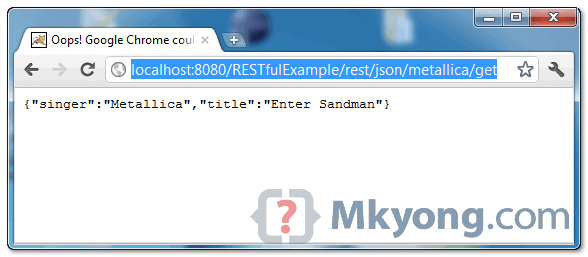Jersey uses Jackson to convert object to / form JSON. In this tutorial, we show you how to convert a “Track” object into JSON format, and return it back to user.
1. Dependency
To make Jersey support JSON mapping, declares “jersey-json.jar” in Maven pom.xml file.
<dependency>
<groupId>com.sun.jersey</groupId>
<artifactId>jersey-server</artifactId>
<version>1.8</version>
</dependency>
<dependency>
<groupId>com.sun.jersey</groupId>
<artifactId>jersey-json</artifactId>
<version>1.8</version>
</dependency> 2. Integrate JSON with Jersey
In web.xml, declares “com.sun.jersey.api.json.POJOMappingFeature” as “init-param” in Jersey mapped servlet. It will make Jersey support JSON/object mapping.
<init-param>
<param-name>com.sun.jersey.api.json.POJOMappingFeature</param-name>
<param-value>true</param-value>
</init-param>File : web.xml – full example.
<web-app ...>
<servlet>
<servlet-name>jersey-serlvet</servlet-name>
<servlet-class>com.sun.jersey.spi.container.servlet.ServletContainer</servlet-class>
<init-param>
<param-name>com.sun.jersey.config.property.packages</param-name>
<param-value>com.mkyong.rest</param-value>
</init-param>
<init-param>
<param-name>com.sun.jersey.api.json.POJOMappingFeature</param-name>
<param-value>true</param-value>
</init-param>
<load-on-startup>1</load-on-startup>
</servlet>
<servlet-mapping>
<servlet-name>jersey-serlvet</servlet-name>
<url-pattern>/rest/*</url-pattern>
</servlet-mapping>
</web-app>3. Simple Object
A simple “Track” object, later Jersey will convert it into JSON format.
package com.mkyong;
public class Track {
String title;
String singer;
public String getTitle() {
return title;
}
public void setTitle(String title) {
this.title = title;
}
public String getSinger() {
return singer;
}
public void setSinger(String singer) {
this.singer = singer;
}
@Override
public String toString() {
return "Track [title=" + title + ", singer=" + singer + "]";
}
}4. JAX-RS with Jersey
Annotate the method with @Produces(MediaType.APPLICATION_JSON). Jersey will use Jackson to handle the JSON conversion automatically.
package com.mkyong.rest;
import javax.ws.rs.Consumes;
import javax.ws.rs.GET;
import javax.ws.rs.POST;
import javax.ws.rs.Path;
import javax.ws.rs.Produces;
import javax.ws.rs.core.MediaType;
import javax.ws.rs.core.Response;
import com.mkyong.Track;
@Path("/json/metallica")
public class JSONService {
@GET
@Path("/get")
@Produces(MediaType.APPLICATION_JSON)
public Track getTrackInJSON() {
Track track = new Track();
track.setTitle("Enter Sandman");
track.setSinger("Metallica");
return track;
}
@POST
@Path("/post")
@Consumes(MediaType.APPLICATION_JSON)
public Response createTrackInJSON(Track track) {
String result = "Track saved : " + track;
return Response.status(201).entity(result).build();
}
}5. Demo
See demo for GET and POST request.
1. GET method
When URI pattern “/json/metallica/get” is requested, the Metallica classic song “Enter Sandman” will be returned in JSON format.
{
"singer":"Metallica",
"title":"Enter Sandman"
}2. POST method
To test post request, you can create a RESTful client (refer to this Jersey client APIs example), and “post” the json format string to URI pattern “/json/metallica/post“, the posted json string will be converted into “Track” object automatically.























 247
247

 被折叠的 条评论
为什么被折叠?
被折叠的 条评论
为什么被折叠?








